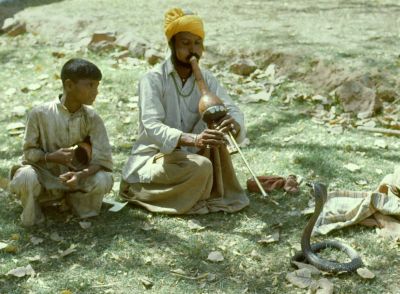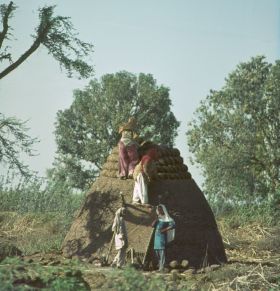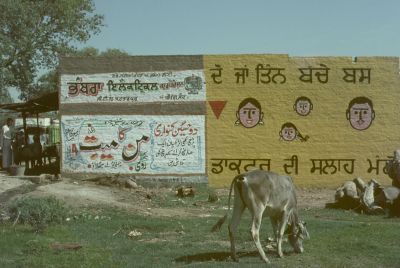| Barelds - Cycling around the world - Cycle stories - Asia, Africa, Europe, America | ||||||||||||||||||||
| home | site map | world | children | recent | cooking | dutch | german | react | ||||||||||||
South-East Asia 1968 (6).

The snake charmer had to give the snake every now and then an encouraging push in order to let her dance.
C
ycling into the country without a map of India and evading Calcutta, appeared to be a difficult task. While searching, we arrived in a suburb. Friendly cyclists guided us through a practically impenetrable traffic in narrow, dirty streets between ox carts, cows, mules and goats, rickshaws and droves of pedestrians. Once outside we reached the main road."Burmah Shell" was written on a petrol station. "Maps", said the attendant. "No I don't have them". "What lies up there", Henny asked. "Oh that", he said and he took the pile. "Here". Overjoyed we looked at the regional maps of India, very detailed. No seeking, no asking anymore, no vague indications of so many furlongs. Also small roads we now could find ourself and we could see when there was a place where you could sleep.
"1, 2, 3, 4". "No 5". we shouted behind our cup of tea in the dark teahouse. The interest now was for the bicycles, not us. This varied from village to village.

Collecting dung and piling up the dried material, is women's work.
There were no appropriate parts of course, but the know how and the ability to improvise were such that everything could be repaired. It was for the bicycle menders even an honour to repair our bicycles. They didn't want any money for it and while we had to wait, they even offered us tea.
In India everything is transported by bicycle: goats, pigs, fowl, bones and buffaloes, the pedlar and his wares, a father with his wife and children, and always someone on the back, in flapping white robes. Yes, we even saw a naked corpse in a box of chicken wire.
Hey, wake up", Henny shouted. In the middle of the road stood an ox cart, blocking in full width the road. The driver had fallen asleep, the ox had noticed this and stood still.
Cars and buses were rare, even on the main road: we were always the person who had to overtake. Either ox cart who went aside with a jerk at least when the driver was awake, but also rickshaws, horse carts, sheep and goats, camels and elephants, pack donkeys and sedans.

There were enough large billboards for 2-child families, but it didn't help much.
An unbelievably fascinating whole, you were not bored for one second on the bicycle.
To get out of the Ganges Plain we had go up the hill a few kilometres. When I reached the top of the pass, Henny was already talking to a hermit. He gave us water and pieces of a coconut. "Marvellous that a woman can cycle up this mountain", he said. His dark eyes smiled, the only part of his face that you could see a little, between his long uncombed "rope hair" and beard. Appearance is not important for these people. His shelter was just alongside the road, partly a cave , partly of planks. His only furniture was a leopard skin !!
| World around (nl) | South-East Asia | << Previous | Next page >> | |||
| Barelds on bicycle through the world - Cycling in Asia, Europe, Africa, America | ||||||